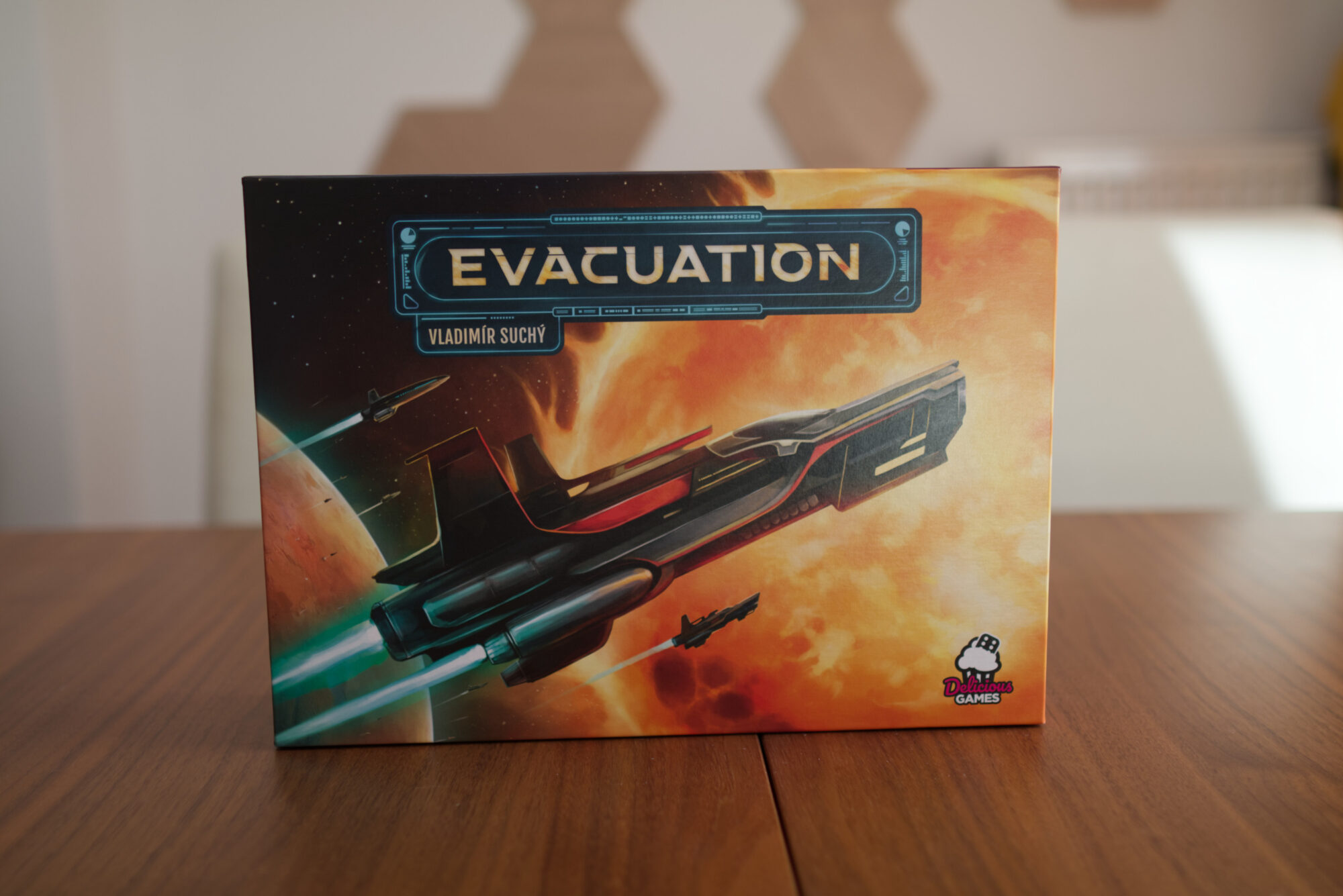For this episode of Origin Stories, I had the great pleasure of interviewing Vladimír Suchý. In my mind, his name is synonymous with “something unique and different”. Similar to reading a great novelist, I’m always looking forward to playing his new releases, regardless of the specific story or mechanisms. Whatever one of his games might be about, I know there will be something interesting in there to discover that I haven’t seen in any other game.
Despite the reputation that Vladimír and his company Delicious Games have managed to build up for themselves, there is little to be found about him and his design process – the rare exception being a BGG Designer Diary on his 2023 releases. So when I reached out to him to talk about Evacuation, it came as quite the surprise that he wrote back right away and agreed to let me pick his brain for this series.
Besides his general approach to design and playtesting, I of course asked him about his perspective on the race-vs-points mode discussion, player interaction, and how Delicious Games manages to have these consistently huge releases at Essen SPIEL every year. He even dropped a teaser for his next game!
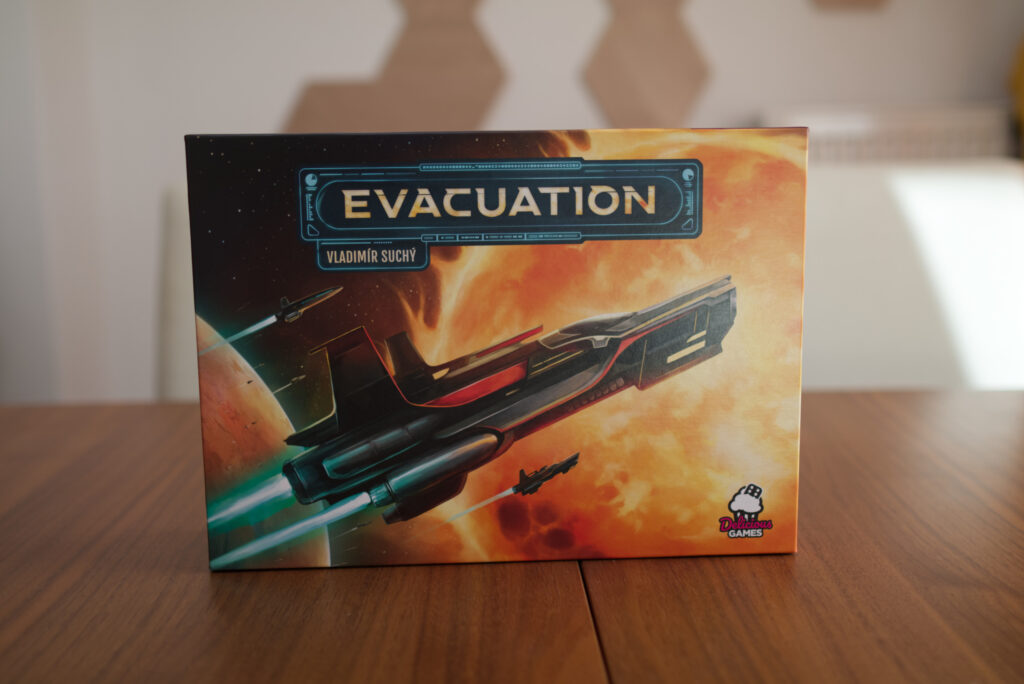
Hi Vladimir!
Thanks for agreeing to do this. I’ve been enjoying your designs ever since I was first introduced to you and Delicious Games with Underwater Cities. You seem to have a neck for breaking the mould and bringing us something we haven’t seen before with each of your games.
Inception
With Evacuation, you abandoned the typical Euro-formula of building something up from scratch and replaced it with more of a U-shape where players have to dismantle their own economy to then rebuild it. Where did that idea come from? Was there any particular inspiration for it?
I was not inspired by anything specifically. I had an idea of this mechanic in my head for about 2-3 years, but only as a general idea. Whenever I am looking for game ideas, I am also trying to look at game mechanics from the other side – the opposite view – to create something new and original. That was the impulse to create a game mechanic based on destructing an economy with following building up. It was similar to the design approach I used while I was designing Last Will where you don’t gain VPs but you have to lose them.
When you first started working on the game, what kind of experience were you aiming for? What kind of decisions or conversations did you imagine the players would have?
The main idea was to let players have different feelings from playing my game compared to playing other titles. Other economic games usually start with the player owning a single building and a few resources and he has to improve the overall economy which is increasing. This is the issue I wanted to think about in a different way and make players do so too. I wanted to force players to disassemble their developed economy. As a consequence, players have a dilemma what to disassemble first, second, etc. and how fast this process will be.
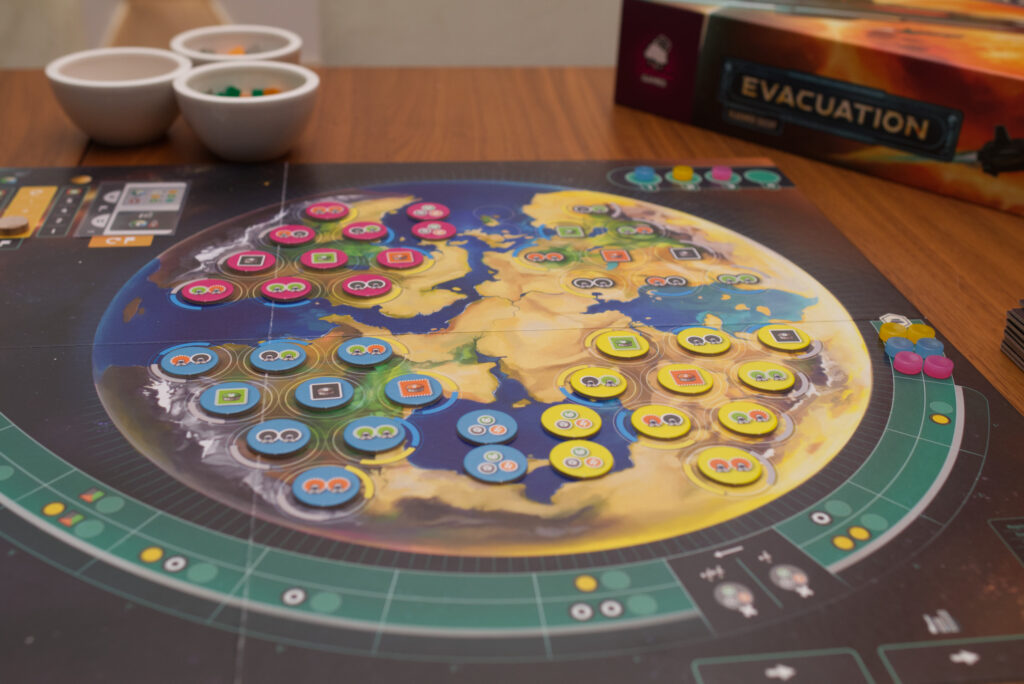
What type of interaction did you want to have between the players? In some aspects, Evacuation seems more solitaire with only indirect competition (e.g. buying a ship or stadium someone else could have used as well) and in others designed for direct blocking (e.g. someone remembering which infrastructure pattern another player needs and then populating exactly that last missing spot).
I usually prefer non-direct interaction between players, for example occupying more valuable spaces on the main board, fulfilling achievements faster, or compete on the player order track. I play area control games but it’s not my favourite mechanism. I don’t like direct interaction such as stealing some resources from another player or destroying opponent’s buildings, etc. These mechanics I never use in my games and I am usually avoiding playing games that allow doing that.
In the base game of Evacuation, there is interaction mainly on the player order track (the advantage of potentially occupying better spaces on the progress track or on the New World faster). There is also some advantage while choosing cards and tiles from the shared markets. I find this type of interaction sufficient and comforting for me. But there are two optional modules which add interaction: fulfilling the achievements and area control via the Line Majorities module.
Evacuation has a particularly tight economy where even a single cube can have lots of consequence. Were you afraid that might become frustrating for some players and reduce the potential audience for the game?
I am afraid I didn’t think about it this way. The stringency of economics was a part of the used mechanics. I didn’t find any other system solution which would have met my design requirements of creating a game of that playing time.
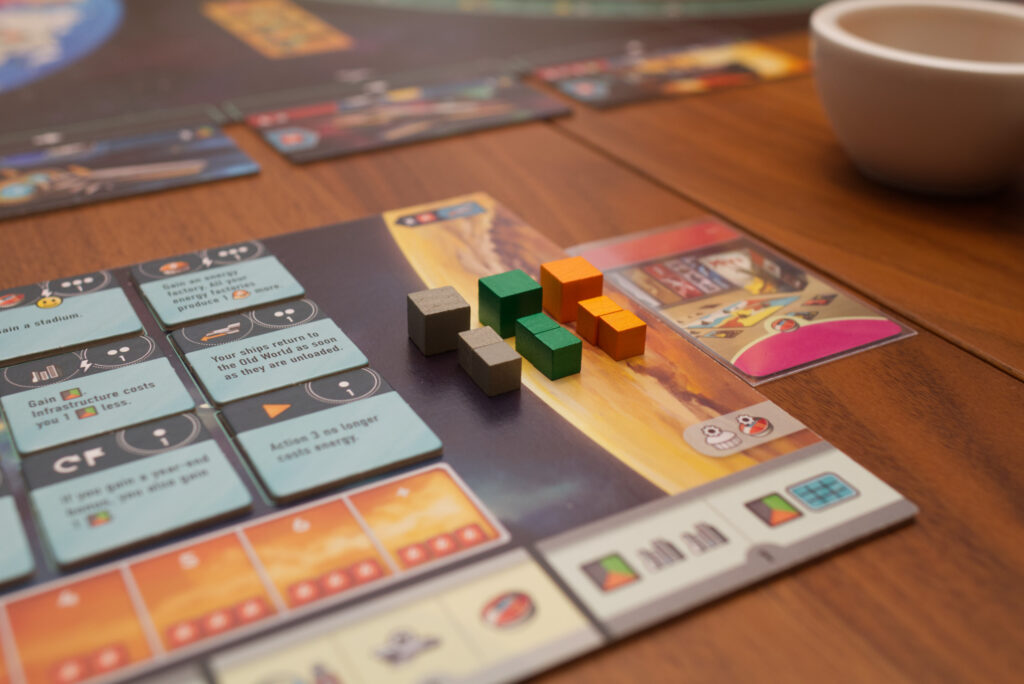
Having players on top of it dismantle their own economy is also a risky ask emotionally. It’s like asking them to shoot in their own foot while at the same time telling them to start running. Do you personally enjoy these kind of dilemmas where the choices one makes unavoidably have a negative impact as well?
I felt the problem of the destruction of your own economy from the beginning of the design process. The first thoughts about disassembling my own wealth made me feel depressed. I asked myself: „Wouldn’t it be depressing for players too?“. That is the reason why I make players at the same time build their economy on the New World. To not only do depressing moves but also work on progress in a new place of living.
Regarding decisions, I like it when there is a dilemma in a game. That way a player has to decide between uncertain choices which he couldn’t calculate before he acts […] the decision is a matter of guesswork, feel or strategic choice. This decision making is also included in Evacuation. I wanted players to decide between stronger actions which bring them only short and slower movement along the progress track and weaker actions with faster movement on it.
As far as I know, you’re a professional, full-time designer. So you can’t just design what’s fun for you but also have to think about each game as a product. How much do you design a game for yourself and how much for an audience?
I am not a full-time designer, I have my own job during working days. Delicious Games is a family business, but the only full-time employee is my wife. Our children also help us and do it as a part-time job.
I design games mostly for the players – my fans. I am trying to think of something to capture. I am watching the reactions of players and follow the trends, so I am thinking this way about my designing too. But first and foremost, I have to enjoy the design process and especially playing the developed title and testing it.
My own games are not on our board game table after we release them. While creating them, I play and see a lot of testing games, go through the rulebook so many times. In some phase of the process, testing and checking all just is work, so I am happy when it is finished and that’s it. So I am not so much interested in playing my own titles. But when I recently had to play some of my titles (Shipyard or Underwater Cities), I liked them very much again 😀
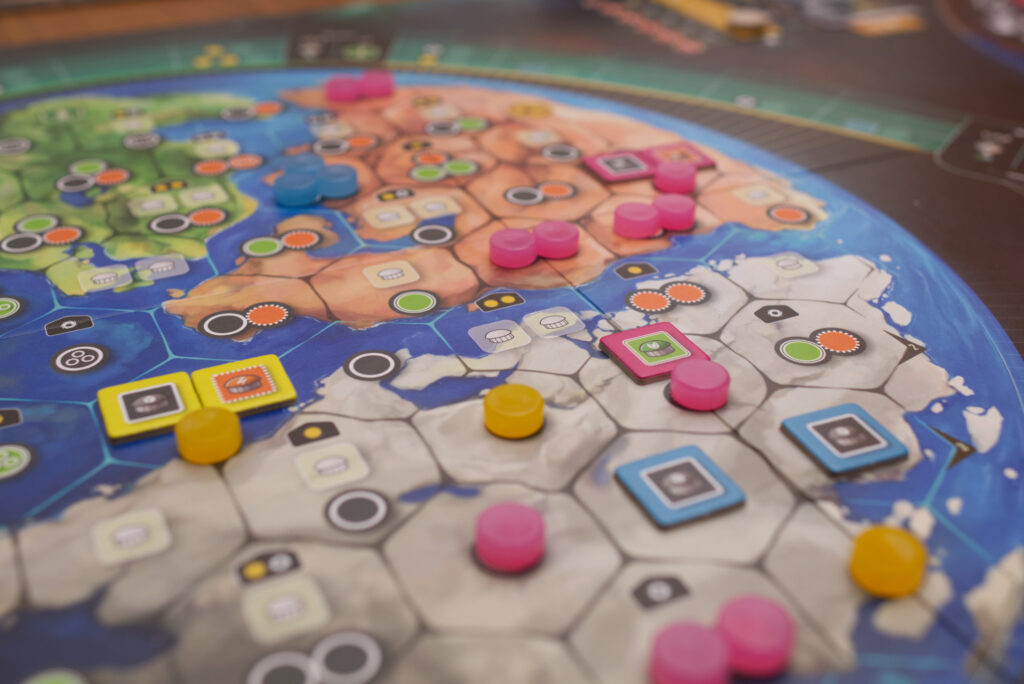
Surprising Choices
There were a number of things that surprised me when I first played Evacuation. For one, it is rather quick to play for such a heavy game. Did you always aim for the sub-2 hour mark? Did you also experiment with more than four rounds?
Yes, it was a goal from the beginning to not design a game with such a long playing time. I was planning for a playing time of 120 min as the maximum. I remember well that some of the earliest versions had 5 rounds, but I did shorten it immediately. The game play was longer when players played with action cards as they were thinking about the text on it.
The playing time and sales? Family games are a special category which requires shorter playing time than other strategic games. I think players playing Eurogames tolerate longer playing times than was typical years before. When I started playing games, it was normal to fit playing Porto Rico – even with its rules explaining – into 2 hours. Today, some players are sitting and playing new Euro titles for 210 min and don’t perceive it as a problem. Games today are more complex and have more rules, turns are longer, there is a lot of choices and winning strategies how to play, so the length of play is also increasing. People also buy a lot of these games despite their long playing time. Years ago, it would have been a problem to sell them.
What makes the choice of only four rounds even more interesting is that a lot of actions players make take two turns to “fulfil”. When they evacuate something, the hit to their production is immediate but it takes two rounds to get benefits from it (one to build, and the next to do a production again). When they send a ship, it takes another round to get it back before they can use it again. Was this delay intentional?
Yes, I could say that delays were on purpose. I tried from the beginning to set the economic curve to the U-shape where you’ve got a high level of production at the start of the game, in the middle it is the lowest, and then it increases again.
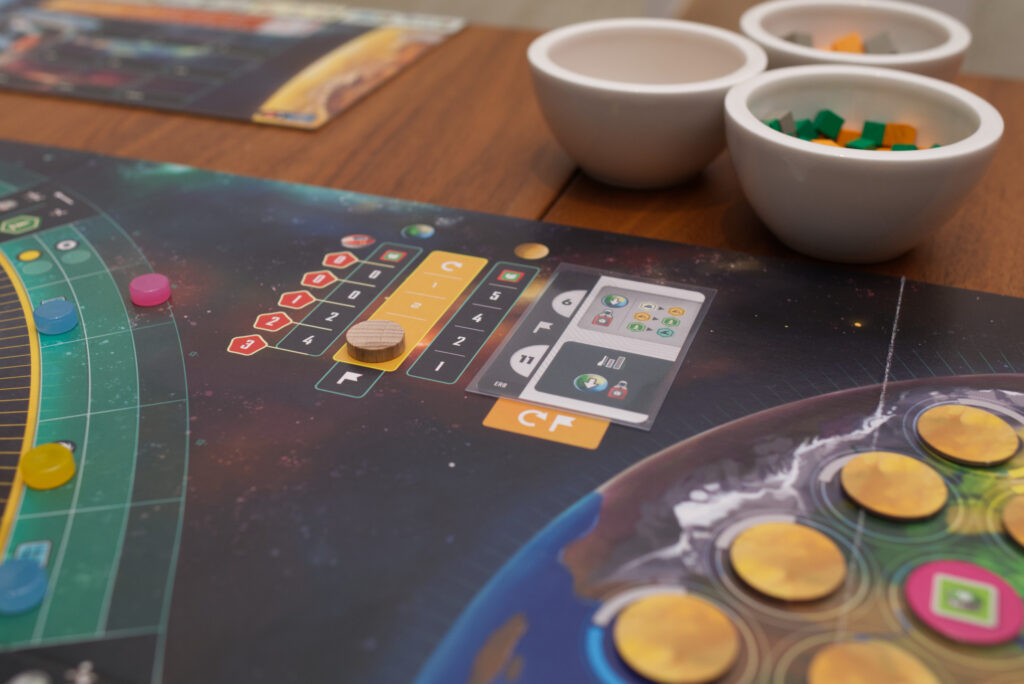
It almost seems like you wanted everything to have a negative component to it. Take for example the progress track: a lot of games would probably have left it as “the farther you go, the better areas you can populate”. But you deliberately added those base production tiles that go away when the satellites move past the first segment. What was the reason you added those tiles?
I remember well that these productivity tokens were in the game from the beginning or almost from the beginning. It helped my idea of a U-shape curve to add it to the game. Having transitions on the progress track and their passing also creates dilemma of playing cards with different strength and makes it more interesting.
I also found the idea of receding satellites (AI that control the process on a planet) thematically interesting. They are moving along the progress track and get father from the home planet so it causes slower communication and decreases the efficiency of all the managing processes. On the other hand, when satellites are getting nearer to the New World, communication velocity speeds up and the efficiency of processes and also productivity is increasing again.
The thing that seems to catch most players off guard is that there isn’t just one way to play Evacuation. There is race vs points mode, normal vs advanced actions, public objectives, line majorities. At least the first two are not just small add-on modules but substantial changes to the game. Why did you keep all these options instead of choosing “the best” version of Evacuation? Was Kickstarter with its many stretch goals an influence?
Originally, Evacuation was designed as a race game. I didn’t want to create another “point salad“ but a game that’s a little bit different. However, after some short testing I found out that it would be less variable and replayable. That was the reason I also added the points mode to it. Then I asked myself and also other testers whether I should keep the race mode or whether I should change the whole game to the “point salad“. And what about cards and text on them? But different testers had different opinions.
Finally my idea of keeping all modes in the game won. Players could choose the mode they want, which I’ve found was the best solution. I also consider the game more replayable this way in case players will choose to play more modes. The last consideration was the playing time in a full game with cards and points. Explaining rules and playing the game itself were becoming too long in that case. On the other hand, the race mode was the shortest one.
Kickstarter didn’t inspire me in any way. I’m not a fan of Kickstart and I only follow it a little.
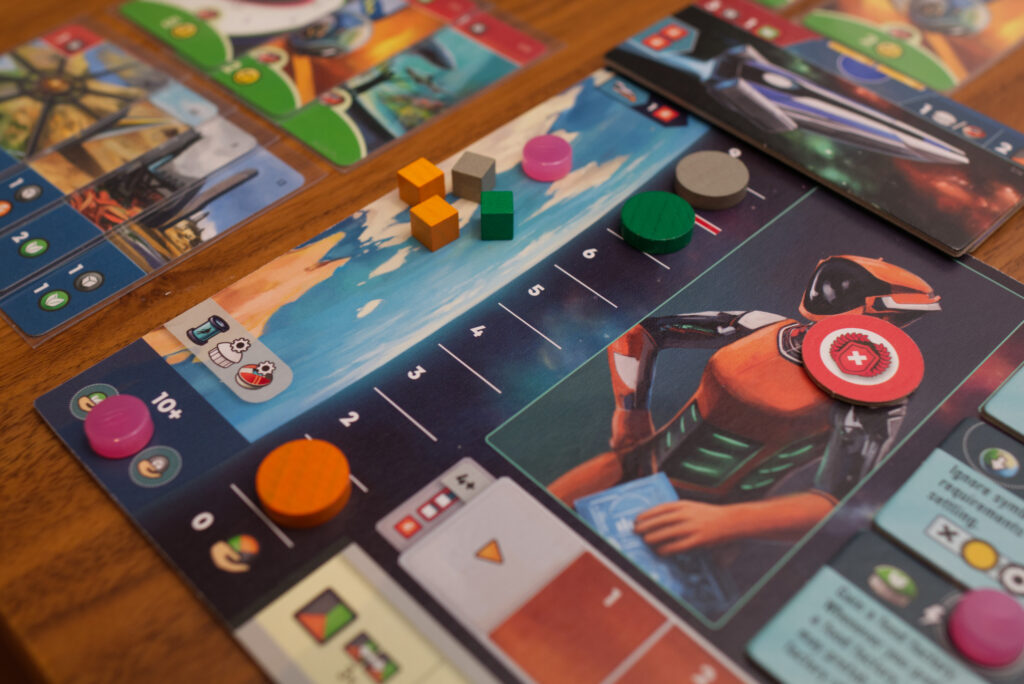
Were you surprised by the amount of people that seemed to have been turned off by race mode? At least among BGG users, podcasters, and YouTubers there were a number of cases where players tried Evacuation once in points mode and never played it again. Or their rating of the game changed substantially after switching to points mode with goals.
Yes. After the bulk of initial buyers had received the game, I found out that maybe including the race mode as the base one was not the best solution. During testing, I discovered that after a first game of race mode, players were more interested to play again when I explained all the possibilities and modules. In real life, some of the players were maybe repulsed by points mode to play again. Today there is a huge amount of games on the board game market even for specific types of games such as Eurogames. Players often judge games according to first impressions, which makes them important for a good game reception and sales. In case players don’t enjoy a game enough during the first time playing, they try to play other new titles and don’t come back to the first one. They are not interested in more modules or some deep playing….
It seemed to me that the game was well rated by reviewers and people who wanted to understand the game concept deeper. Evacuation is giving them lots of options to customise for their enjoyment and good feelings while destructing and mainly developing economics on the New World.
The New World
How did you approach designing the map of the new world? Of course each habitat gets more and more action-efficient, but are there other underlying rules? For example what’s the role of desert? In my plays, most players try to skip on it and either go for Tundra to complete lots of infrastructure or push progress to have access to forest.
I tried to construct each area to be more interesting than the previous one. The desert allowed players to place more tokens during one action, so they gain production. I didn’t have a feeling that desert spaces were worthless. They are also important in combination with infrastructure cards in points mode or for line majorities in the area control mode.
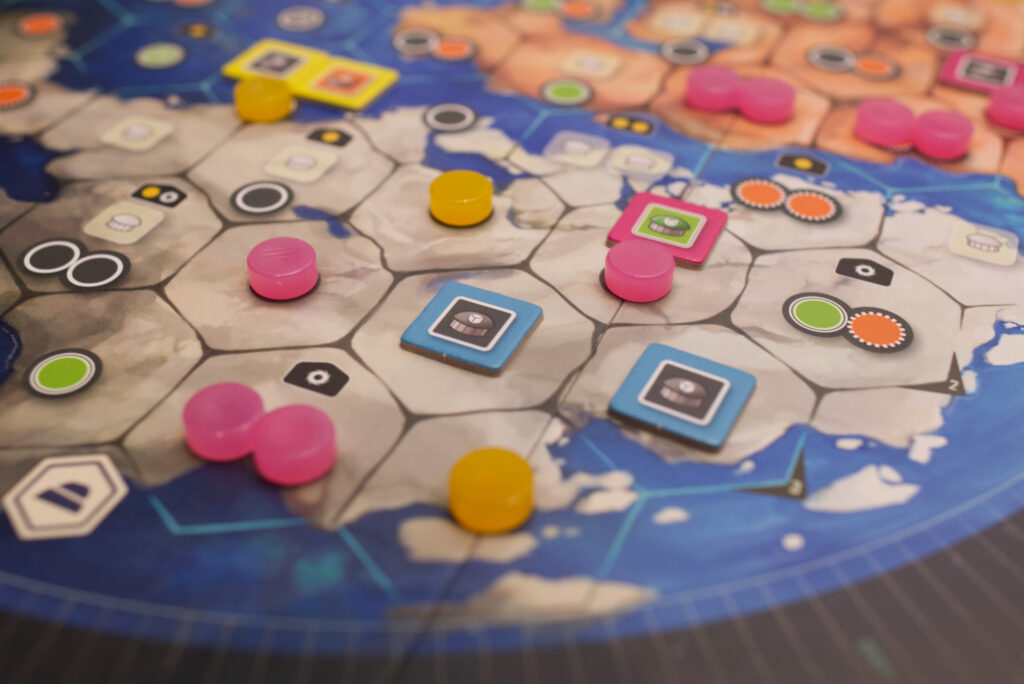
I was a bit surprised that the size of the map doesn’t change for lower player counts. Was it just not necessary in your experience or did you want to have a different feel when comparing the two player and full four player experience?
I was thinking about creating a smaller map for 2 players during the design process. Ultimately I decided not to add it because in that case I should have also limited infrastructure cards and also the amount of spaces on New World would be smaller so there won’t be as much variability on these cards. Of course the modifications to the New World wouldn’t have been so huge to substantially change the whole game, but setup and rules for 2 players would be more complicated. In the end, I just kept the one map.
Something I enjoyed way more than I thought I would were the infrastructure cards. They bring relatively easy and high rewards but also can be risky if the other players pay attention and block you. In some sense they feel like added-on. There are an unusual low amount of these cards for example. It’s also the most obvious interaction point between players in a game that otherwise only has indirect competition. At what point in the design process did you add them and why?
I think infrastructure cards have been in the game since the first tests. Rather than interaction, it was about giving players more options to play the game and adding another element to the game that the player must take into account while occupying the New World. The small number of cards was due to the fact that the [building patterns] of the tasks on the cards began to repeat themselves and even back then I had to add a rule to the game where some cards could not be owned together with others. In contrast, a larger number of such cards would limit the offer and put pressure on similar combinations on the board. Originally there were more cards and more complex land/character patterns. But it was too complicated for players during their first game regarding orientation and description of combinations. Then the players that previously preferred them they didn’t play them at all. The current number and complexity of shapes was a compromise.
As a result, it brings pressure on turn order, selection of cards, and occupation of strategic fields. As I already mentioned, I saw the interaction in turn order in general, in the movement on the progress track, when it is advantageous to get some interesting bonuses and symbols, and also in additional modules.
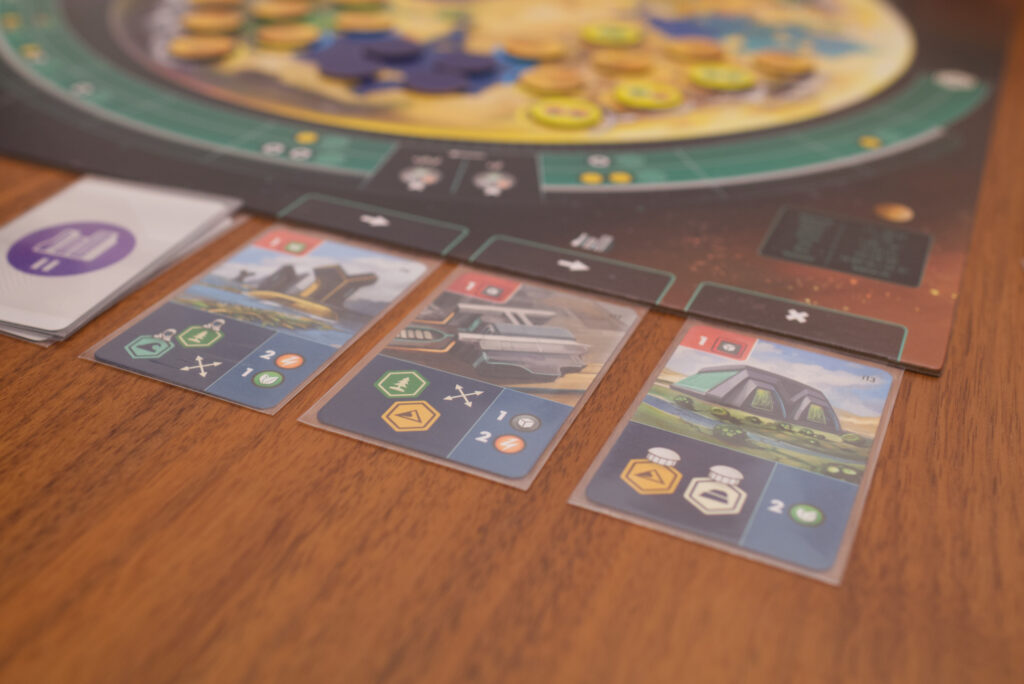
Besides the primary goal of raising the New World production, there are a number of secondary goals that affect how well a player will score. To add a penalty for each piece a player doesn’t evacuate feels like a natural choice. But what was your motivation to add the element of having to feed population and build stadiums? And why two different mechanisms that seem to do very similar things mechanically: adding pressure mid-game?
Generally in Eurogames, players have more choices what to do, more resources and more winning strategies etc. I had 3 resources in the game – energy, steel and food, so I had to give them some use and importance not to be useless. So feeding of population and building of stadiums was the opportunity to use resources effectively.
Why did you end up with 3 resources and not for example just energy and metal? Did you start with the idea of three resources and then figured out what they would do – or – was it thematically that you definitely wanted to have food in the game?
If I remember correctly, I had been thinking about food from the beginning for thematic reasons. It seemed logical to me that it was one of the things I had to solve when leaving a place and at the same time when building a colony. The original feeding system was more complex and depended on the number of people on a planet (old or new). But I removed that because it created too much calculating and was not clear.
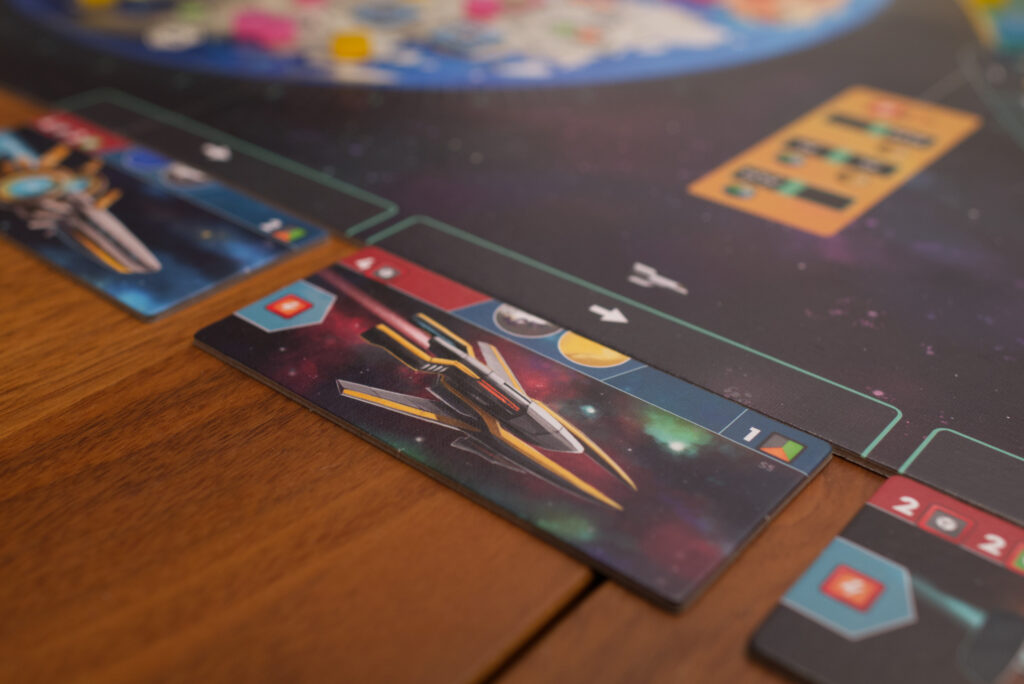
Playtesting & Release
With economic games, lots of playtesting and balancing seems to be essential. Do you have a particular approach how you playtest games?
Yes, it is true, deep testing of prototypes is really necessary. Every time before Delicious Games is sending finished data to the printer, I am saying to myself „oh, there should be more tests of the game, is everything OK?” At the end of the design process, I’ve always got doubts whether there is nothing non-balanced or any elements breaking some mechanics.
First of all, I am testing prototypes on my own and with my family. Then I bring it to as many testing groups as possible to find out first impressions and decide what mechanics should stay in the game and what is necessary to replace. After that, when the general frame of the game is finished, I try to test the game deeper to balance it well. At the same time, I test the game with „novices” – people who’ve never played the prototype to find out whether icons and symbols are clear enough.
We are visiting game conventions during the year and there are also special Delicious Games testing days for these purposes. We play a lot prototypes in all phases of the design process with my family as Delicious Games is a family business. Also playing the solo mode helps me balance the game and avoid mistakes.
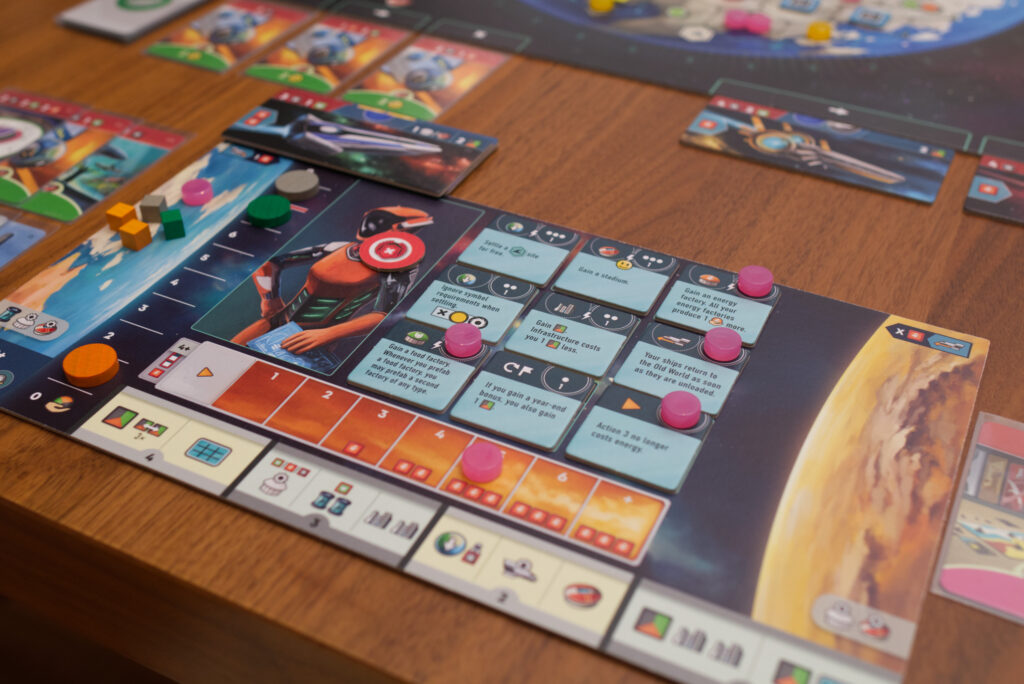
How do you decide when a game is “ready”? Do you work towards a deadline like releasing at SPIEL Essen and make the game as best as you can in that timeframe or do you have a particular criteria that tells you a game is done like getting positive playtest feedback?
Right now, I am focusing on designing one title a year. Usually during summer, I have a first prototype of a new game. Then it is tested in about 9 months to be released at Spiel Essen the following year. This determines the length of the testing process and thus the whole time frame. You could improve a prototype endlessly. But with this time frame, there is a need to be in time and stop improving on the exact date.
When it comes to a game itself, yes, I would rather design a game which will be in the TOP 50 on BGG. And if I would know how to design such games, I would do it 😀
On the other hand, if I would compare all my designs with my “best” title, I would be paralysed and I would never create another game. I think it would be a big shame in case of some titles released by Delicious Games and also by Czech Games Edition in previous years … I think all my titles have found their group of fans who love them.
How was it for you when the game finally came out? Where you happy with the reception? I saw the giant line at your booth at Essen!
Our new title is always attracting attention in Essen. This is a real pleasure for us. We usually sell a lot of copies there and it makes us very happy. I feel some hype before Essen connected to our titles and I don’t even know why. As I said, it is a real pleasure, but on the other hand it is very taxing for me. During „Essen time”, I always think about it, whether our new title will meet our fans’ huge expectations. So the whole situation is very taxing for us.
In the last years, I focus rather on following reactions of customers who buy a game at SPIEL and play it for the first time. And also other reactions that follow. This determines sales a little bit and somehow the overall success of the title. In case of Evacuation, we can’t judge the final success now because some language versions are still getting printed and are not finished and distributed yet. But it is a good sign that the US edition (by Rio Grande Games) is mostly sold out and a reprint is already being prepared. And we also don’t have English copies for Europe anymore.
But for example Woodcraft – which seems not to have such a high rating on BGG – is quite successful. We reprinted its English and German versions twice already, so sales were quite high in that case. We consider it a success today because there is such a high amount of new titles being released which generate more and more new reviews on social media. All new titles today have very short game life (5 mins of fame), except some very hyped and good titles.
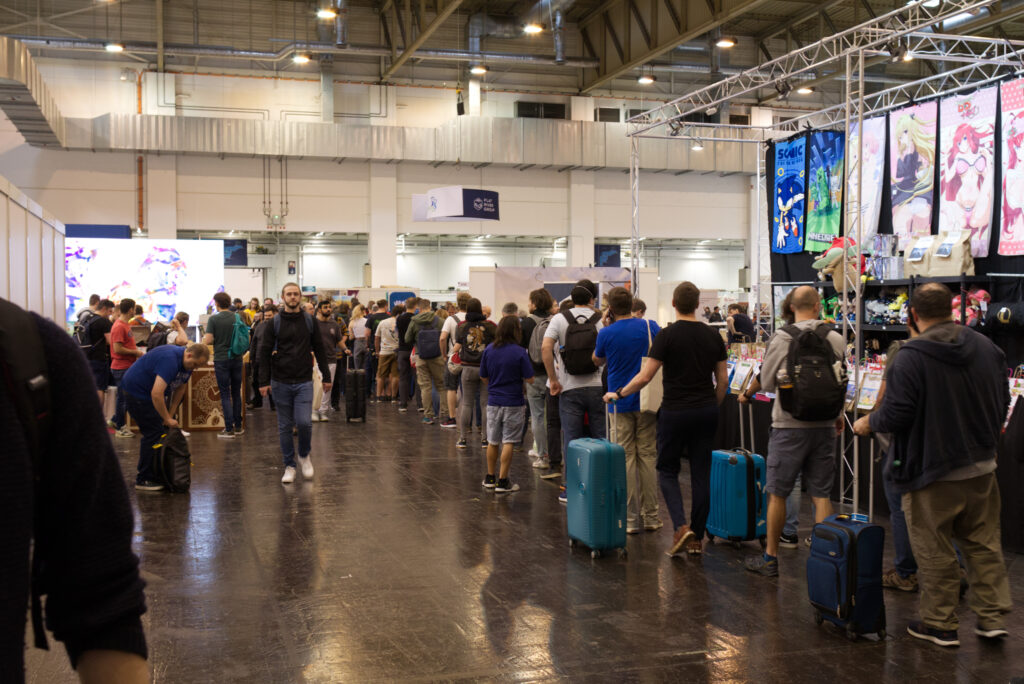
In my perception, you almost like clockwork release one new game each year, each year it makes a big splash at Essen SPIEL, and each year you seem to sell a ton of copies. It’s very impressive! What’s your secret to be able to have sufficient supplies when other publishers run out on the first or second day?
We produce our games in the Czech Republic. Our company was founded 6 years ago, so we are able to estimate how many copies we should bring to SPIEL to satisfy all (or most) customers. We are focusing on satisfying our fans really thoroughly. We think it is important to sell a lot of copies directly to fans to gain their first impressions and reactions and especially to make them HAPPY. We usually have some preorders from shops and distributors before SPIEL, so we are bringing them games to SPIEL or keeping some copies for them in our stock. After the fair, we are sending their consignments to their warehouses. We don’t know why some other publishers don’t have enough copies at SPIEL. We consider bringing sufficient amounts of copies for a new title very important.
I’m always curious what the economics of such a release are like. Is one big game a year at that level of success enough to provide a living for you? Or is this more a side job for you and you have other sources of income such as design work for other companies?
As I said, designing of games is my part-time job. My games are released by our family business with externally working graphic designers. For our company, it is enough to release one title per year and it would probably be enough also for me to work there as a full-time designer. But I love my civil job. And likely I would need to work on more projects as a full-time designer or work for some other companies to help them design games.
You mentioned that you follow BGG discussions. Was there any feedback that surprised you?
I follow discussions on BGG about our games very closely and also look at reviews. I always try to learn something new from designing every new title. What was surprising for me? Negative reactions to race mode. This feedback was totally different from the feedback of my testing groups while I was testing the prototype. Or did I understand the feedback incorrectly? Testers also wanted to play more modules and were more motivated than some players seemed to me after the Evacuation release.
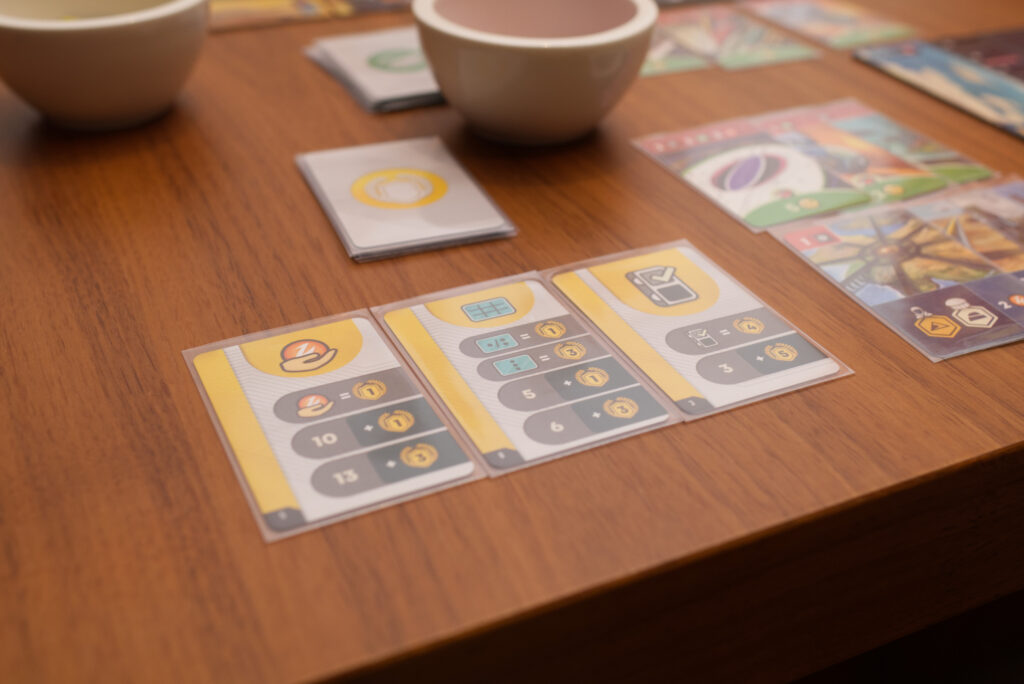
Wrap Up
What was the biggest “a ha” moment for you during the development of Evacuation? Any particular learning or new idea you take with you for your next design?
Nothing comes to mind right now. Of course the heaviest was creating the U-shape economic curve which I didn’t find in any other game and I had to simulate only in my head without the help of any other title.
Do you have any future plans for Evacuation such as an expansion or variants?
I don’t have any plans to work on an Evacuation expansion. As I always mention, I am not a big fan of any expansions. After release of our new titles, I am not coming back to them so often, except for following any comments and reactions on it. I try to learn from it always, to next time design some better game than the previous was. I rather work on new titles than on expansions. I try to include more variability to a base game. I mean that expansions make sense for card games such as Terraforming Mars or Race for the Galaxy because they add more cards which is better for wider variability there. Despite this fact, there is an exception… I think about one new expansion to my game Underwater Cities.
I don’t plan any Evacuation expansion. Just now, I am focusing on designing our new title for SPIEL 24.
Okay, I have to ask: can you already give me a teaser on what you are working on?
Yes. Also for this year, there will be a new game from Delicious Games in Essen with me as the sole designer. It’s called Resafa and it’s set in the 3-4th century AD in the city of Resafa, which lies in today’s Syria. This city was a commercial one and in order to live there, it collected water in huge reservoirs. So the game will be about trade and building canals in the city. The main mechanic is actually a reverse mechanic from Underwater Cities. Instead of having cards in my hand and playing them for events, I have events in my hand and can use them to get cards (among other things). The reverse is also the case. The underwater location takes place in the desert 😀 I think it’s a bit easier than the last two games and it’s more loose with more resources and not as tight.
Sounds great, looking forward to it!
And finally, what’s a tip or strategy you would recommend players to try out?
I’ve found it interesting to try to play particular technology branches (columns) and adapt strategies to them. I also tried to play different ways of moving along the progress track – to go fast or to go slowly, both strategies can help players win the game also with the use of any special technologies.
Let me close this by once again thanking you for letting me pick your brain a bit. Evacuation is definitely the most unique euro I’ve played in 2023, so it’s great to be able to learn more about your design choices and thoughts behind it.
Note: This interview happened in writing and involved translating between English and Czech. Some of the phrasing has been cleaned up during the final editing process to improve readability but kept as faithful to the original as possible.
To read more about Vladimir’s designs, check out Delicious Game’s website or my reviews of Evacuation, Woodcraft, and Messina 1347.
If you enjoyed reading this interview, please leave feedback in the comments. Doing in-depth interviews like these takes a lot of prep & research and it’s really rewarding to see that so many of you seem to enjoy reading them. Showing your support helps getting future interview partners on board! You can find more interviews like these in the interview section.
